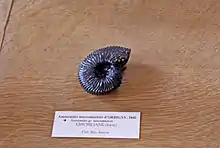Neocomites
Neocomites is a genus of ammonite from the Lower Cretaceous, Berriasian to Hauterivian,[1] and type genus for the Neocomitidae.
| Neocomites | |
|---|---|
 | |
| Fossil of Neocomites neocomiensis from France, on display at Galerie de paléontologie et d'anatomie comparée in Paris | |
| Scientific classification | |
| Kingdom: | |
| Phylum: | |
| Class: | |
| Subclass: | |
| Order: | |
| Superfamily: | |
| Family: | |
| Genus: | Neocomites Uhlig, 1905 |
| Species [2] | |
| |
Description
The shell of Neocomites is fairly involute and compressed with flattish sides; covered with flexeous ribs that branch in small sheaves from faint umbilical tubercles, in some branching again or intercaled further out on the whorls, ending in small oblique bullae in either side of a smooth flat venter. Ribs may cross the venter transversely on later whorls. Sutures have deep 1st lateral lobes.
Distribution
Neocomites has a fairly widespread distribution and has been found in such places as central and southern Europe, North Africa, Madagascar, northern India, Borneo, Sumatra, Texas, Mexico, Colombia (Macanal Formation, Eastern Ranges),[3] Peru, and Argentina.[2]
References
- Sepkoski, Jack (2002). "Sepkoski's Online Genus Database". Retrieved 2014-05-28.
- "Paleobiology Database - Neocomites". Retrieved 2014-06-23.
- Piraquive et al., 2011, p.204
Bibliography
- W.J. Arkell, et al., 1957. Mesozoic Ammonoidea, Treatise on Invertebrate Paleontology Part L, Ammonoidea.
- Piraquive, Alejandro; Juan Sebastián Díaz; Tomas Cuéllar; Germán Pardo, and Andreas Kammer. 2011. Reactivación Neógena de estructuras de rift del Cretácico Temprano asociadas con la Falla de Chámeza, Pajarito, Boyacá (Colombia): evidencias tectónicas y bioestratigráficas. Geología Colombiana 36. 197–216. Accessed 2017-08-04.
